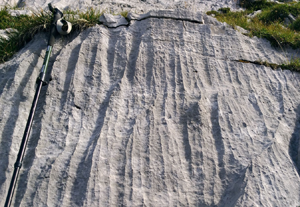Published online by Cambridge University Press: 26 February 2021

In karst and alpine areas, the interactions between water and rocks give rise to a large variety of marvellous patterns. In this work, we provide a hydrodynamic model for the formation of dissolutional patterns made of parallel longitudinal channels, commonly referred to as linear karren forms. The model addresses a laminar film of water flowing on a rock that is dissolving. The results show that a transverse instability of the water–rock system leads to a longitudinal channelization responsible for the pattern formation. The instability arises because of a positive feedback within the channels between the higher water flow and the enhanced chemical dissolution. The spatial scales predicted by the linear stability analysis span different orders of magnitude depending on the Reynolds number. This may explain why similar patterns of different sizes are observed on natural rocks. Results also show that the rock solubility affects just the temporal scale of the instability and the rock inclination plays a minor role in the pattern formation. It is eventually discussed how rain is not strictly necessary for the appearance of linear karren patterns, but it may affect some of their features.